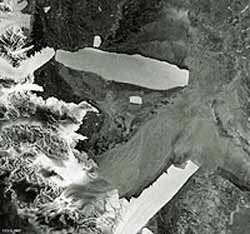The December earthquake and tsunami that killed approximately 300,000 people in the Indian Ocean region was so powerful that no point on Earth went undisturbed, pointing to the need for more active warnings about the consequences of future events, according to University of Colorado at Boulder seismologist Roger Bilham.
Bilham offers his perspective in “A Flying Start, Then a Slow Slip,” an overview of findings on the Sumatra-Andaman earthquake published in the May 20 issue of Scie

Quake was twice as strong, but much slower than thought
The Sumatra-Andaman earthquake that generated a deadly tsunami on Dec. 26 was stronger and slower than most seismologists thought, according to scientists at the University of California, Berkeley, the Wadia Institute of Himalayan Geology in India and the United States Geological Survey (U.S.G.S.).
Using data from global positioning system (GPS) stations around the Pacific and Indian oceans, including previously unav
The earthquake that generated the Sumatran-Andaman Islands tsunami caused massive devastation, but exactly what happened beneath the ocean is the focus of modeling activities by an international team of geoscientists.
“The earthquake rupture ran a distance equivalent to the distance from Jacksonville, Florida to Boston, Mass.,” says Charles J. Ammon, associate professor of geosciences at Penn State. “This earthquake lasted just under 10 minutes, while most large earthquakes take o
In 2006, with the launch of Jules Verne, the Automated Transfer Vehicle (ATV) will become the new European powerful automatic re-supply spaceship able to bring an indispensable payload to the International Space Station and its permanent crew. This first ATV will carry a mix of supplies depending on the Station’s needs and its own payload capacity.
ESA, NASA and Russian counterparts are already defining the priorities to accommodate the most appropriate combination of different sup
A new global wind power map has quantified global wind power and may help planners place turbines in locations that can maximize power from the winds and provide widely available low-cost energy. After analyzing more than 8,000 wind speed measurements in an effort to identify the world’s wind power potential for the first time, Cristina Archer and Mark Jacobson of Stanford University suggest that wind captured at specific locations, if even partially harnessed, can generate more than eno

The mammoth B-15A iceberg appears poised to strike another floating Antarctic ice feature, a month on from a passing blow that broke off the end of the Drygalski ice tongue. As this Envisat image reveals, this time its target is the ice tongue of the Aviator Glacier.
First discovered in 1955, and named to mark the work done by airmen to open up the Antarctic continent, the Aviator Glacier is a major valley glacier descending from the plateau of Victoria Land along the west side